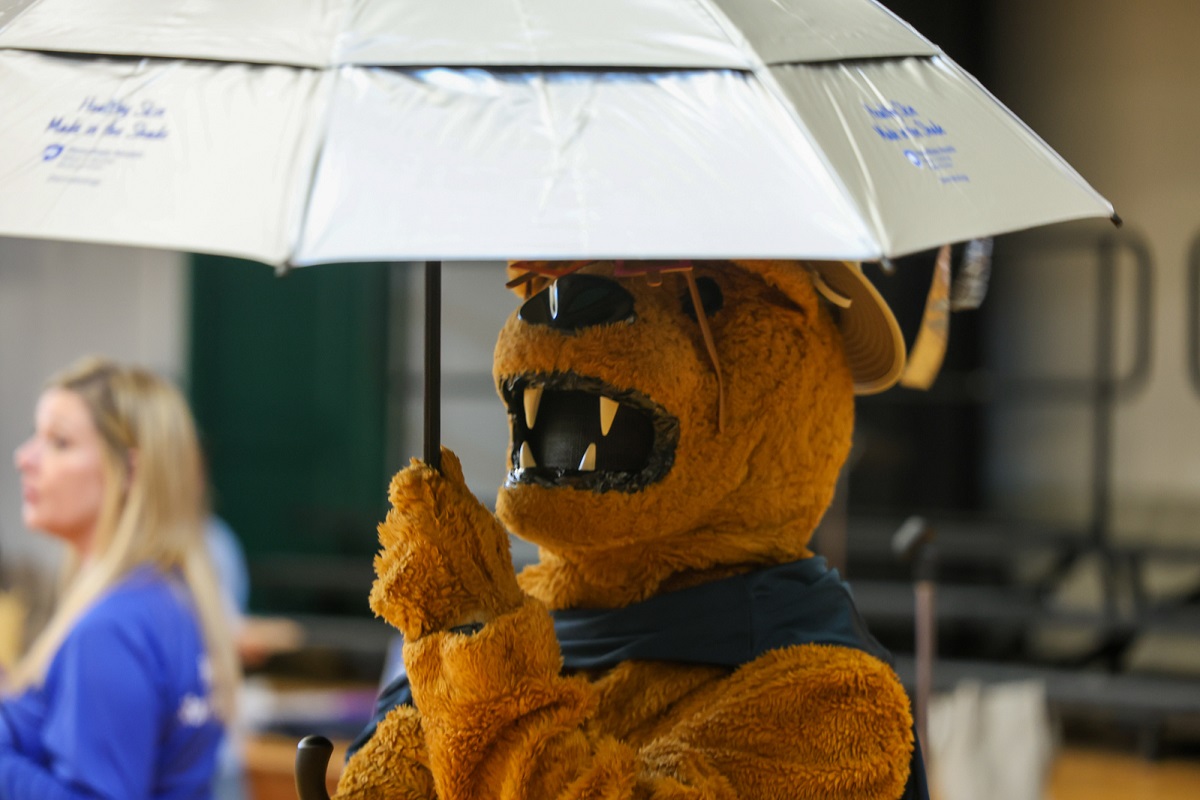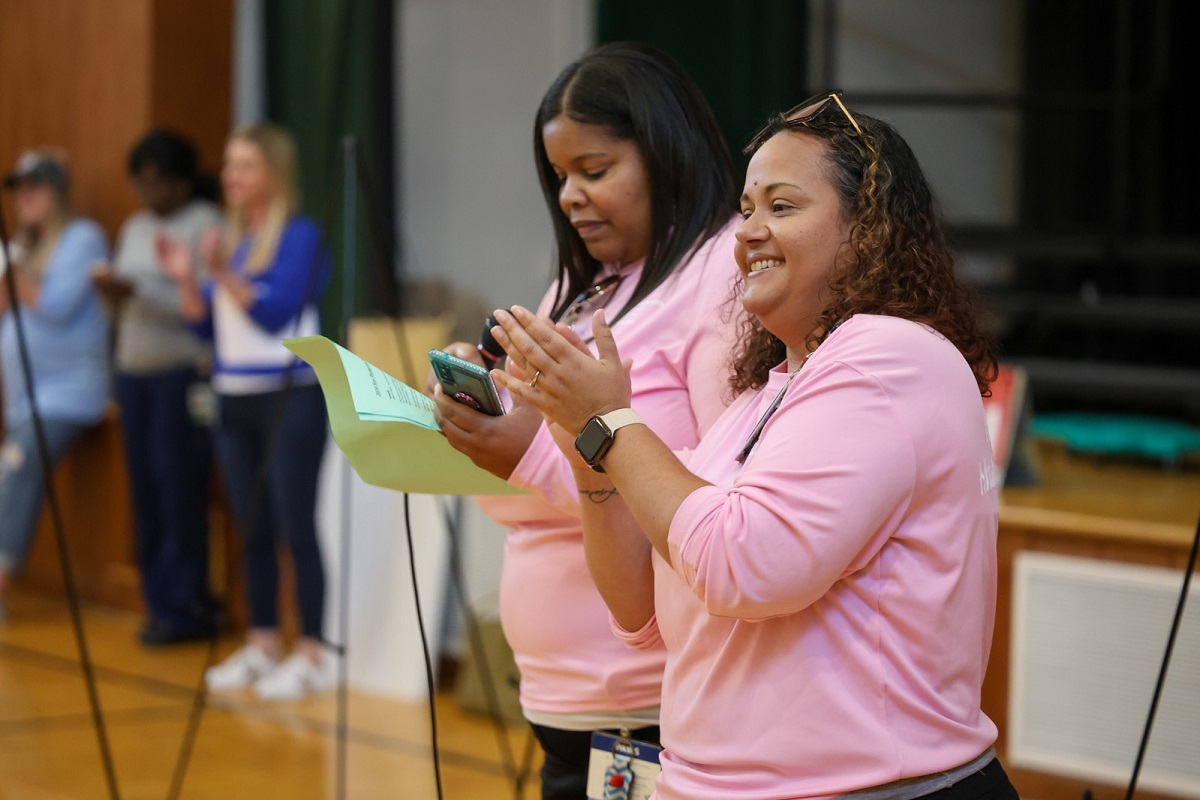‘Reapply so you don’t fry’: Penn State Health Dermatology educates kids about sunscreen

Outside the walls of Henry Houck Elementary School in Lebanon, the sun on the last Friday in May is scorching everything that isn’t protected by shade or sunblock.
Inside the school gymnasium, dozens of third and fourth graders try their hardest to sit still on the floor, but it’s not so easy. It’s one of the last days of the school year, and the sun-soaked landscape beckons. It’s nearly lunch. Rumors of a pizza party are circling and the winner of a T-shirt contest might be announced today. Also, somewhere, hiding, is the Penn State Nittany Lion himself.
“So, we say, ‘Reapply so you don’t fry!’” shouts Talia Gross, medical office assistant at Penn State Health, who wears a T-shirt with a Penn State logo on it. She means, “Continue to put on layers of sunscreen every two hours when you’re exposed to avoid a sunburn.”
“REAPPLY SO YOU DON’T FRY!” the students yell back.
“Reapply so you don’t fry!”
“REAPPLY SO YOU DON’T FRY!”
Another woman dresses up in a costume that looks like a cartoon version of the sun. Laurie Krnjaic, a pediatric nurse practitioner in dermatology at Penn State Health Milton S. Hershey Medical Center, leads the children in a Penn State fight song, punctuated by the shouted phrase, “WE ARE HENRY HOUCK!”
Finally, the Nittany Lion waltzes in, dropping for one-arm pushups and wielding an umbrella to protect himself from the cartoon sun.
Just your garden-variety, late-school-year assembly, right? The gathering seems like a little fun to help the students run out the clock in the final days just before summer vacation. But the Penn State Health employees at the event, while they grin wildly and pose for photos, brought a method along with their madness.
Pass the sunscreen
In Lebanon, 20.5% of respondents to Penn State Health’s 2021 Community Health Needs Assessment said they had cancer, second only to Perry County among the six counties surveyed. Cancer was listed as the eighth highest health concern among respondents to the survey.
Skin cancer is the most common form of the disease in the U.S., according to the Skin Cancer Foundation. One in five people will develop it before they turn 70, and every hour, more than two people die from it.

Talia Gross, medical office assistant, left, and Cindy Rivera, scheduler, talk with the students at Henry Houck Elementary about protecting their skin.
“The goal is to start teaching kids about sun protection now so they’ll likely continue it when they’re older,” Krnjaic said. “Statistics show that our risk of skin cancer increases as we age. So, if they start protecting their skin when they’re young, they’re less likely to forget.”
So, every year for the past four, a team from Penn State Health Dermatology has been visiting local schools for the Sun Protection Super Hero T-shirt Contest with one main goal – getting into the kids’ heads now. And hopefully staying there.
Club shade
“OK,” Gross yells to the crowd, “we apply sunscreen every … how many hours?”
“TWO HOURS!” the students roar in reply.
Gross is one of about 20 people who helped create this event. She serves as the lead of Dermatology’s community service committee, which has 10 members. Five others helped with research, others pitch in with odds and ends. Every year the event entails putting together gift bags, attending meetings and sending out emails ― all after working long shifts at their day jobs as health care providers.
“It’s the kids’ faces,” Gross said. “That’s what I like about it.”
“We want them to stay jazzed about this,” Krnjaic said. “We would much rather come to the community to see people than see them come to the hospital.”
The centerpiece of the event every year is the T-shirt contest. Weeks earlier, Krnjaic arranged with the school to show an educational video on the importance of sunscreen. At the conclusion of the video, the kids are invited to enter their best drawing of a sun protection hero. This year, 83 children from Henry Houck participated.
Next, the staff picks six finalists. Then, they put images of all six designs on posters they hang in waiting rooms and high-traffic areas around Milton S. Hershey Medical Center. The posters include a QR code and an invitation to health care professionals, patients and visitors to pick their favorites. This year, 164 people voted, and they chose …
“Clark Parker!” Krnjaic announces the name of a 4th grader, and the room erupts into shrieks of happiness.
Blown-up versions of all six finalists’ renderings rest on easels on one side of the gym. Clark’s winning entry features a superhero in a long red cape zooming under an orange sun with rays like spider legs and a bottle of SPF-30 sunscreen. Words floating in his wake say “Never Fear Sun Protection Is Here!”
Before they head off to a special pizza party, Krnjaic announces that every student in attendance will receive two T-shirts – both featuring Clark’s design. One includes special UV protection that can actually help shield the wearer from the sun’s harmful rays.
“The other can be your inside shirt,” Krnjaic tells them.
Measuring success
Fun? Absolutely. But is it working? When Gross asks her sun protection questions, everyone seems to have the answers. What does SPF stand for? How do you protect yourself from the sun?
This year, the Penn State Health Dermatology research team led by Dr. Charlene Lam, vice chair of Community Health, is assessing its progress. Before the contest began, students were given a pre-test to see how much they already knew about protecting their skin and then a post-test after they watched an educational video. In six months, they’ll return with another test to see if what they taught the students stuck and if their behavior changed.
“I hope so,” Krnjaic said, because as the children head off to finish another school year, outside the sun is blazing away, and three months of summer days out in it lie ahead.
Educating members of our communities is part of the Penn State Health strategy to improve wellness and disease prevention. Learn more in the Penn State Health Community Health Needs Assessment and Implementation Plan.
If you're having trouble accessing this content, or would like it in another format, please email Penn State Health Marketing & Communications.
